R B. It is grouped with the Morganellaceae and is an opportunistic pathogen of humans. Proteus. Study with Quizlet and memorize flashcards terms like identify which of the following are external structures used primarily for direct contact interactions with other cells a ) Flagella b) Fimbriae c) Cilia d) Pili, Which of the following describes movement towards or away from light ? 7.  6.
6. 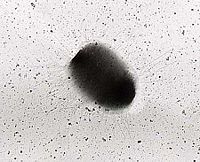 For the wet preparation, a drop of the organism in ; High Visibility: indexed within ESCI (Web of Science), and other databases.
For the wet preparation, a drop of the organism in ; High Visibility: indexed within ESCI (Web of Science), and other databases.  John E. Bennett MD, in Mandell, Douglas, and Bennett's Principles and Practice of Infectious Diseases, 2020 Proteus, Providencia, andMorganella The generaProteus, Providencia, andMorganella are related members of the Enterobacteriaceae that are lactose negative and motile and produce phenylalanine deaminase. The former is more frequently identified in clinical specimens than P. vulgaris, mainly in human urinary tract infections. 1) Phototaxis 2)Chemotaxis, Which of the following bored through the stomach lining and causes The optimum temperature of incubation to best illustrate this property is: A. Proteus vulgaris, Escherichia coli B. Klebsiella pneumoniae, P. vulgaris C. E. coli, Enterobacter aerogenes D. E. aerogenes, K. pneumoniae. The former is more frequently identified in clinical specimens than P. vulgaris, mainly in human urinary tract infections. GLP-1 decreases motility in the antro-duodeno-jejunal region and inhibits the migrating motility complex in healthy subjects and IBS patients. Proteus vulgaris: Red slant, yellow butt, no gas production; H 2 S produced: Salmonella Paratyphi A: Red slant, yellow butt, gas production; no H 2 S produced: such as Sulfide Indole Motility (SIM) Medium. Some of the most common diseases caused by Staphylococcus species include: impetigo, toxic shock syndrome, bacteremia, endocarditis, folliculitis furuncle (boils), and osteomyelitis (bone abscesses). There are a variety of ways to determine the motility of a bacterium; biochemical tests as well as microscopic analysis.If a fresh culture of bacteria is available, microscopy is the most accurate way to determine bacterial motility, and hanging drop method is a commonly used microscopic technique. GLP-1 decreases motility in the antro-duodeno-jejunal region and inhibits the migrating motility complex in healthy subjects and IBS patients. Complications may include dehydration.. Motility Proteus Vulgaris is an actively motile bacterium and well known for the swarming growth on an ordinary medium like NAM. The IMViC tests are a group of individual tests used in microbiology lab testing to identify an organism in the coliform group.A coliform is a gram negative, aerobic, or facultative anaerobic rod, which produces gas from lactose within 48 hours. Shigella flexneri is a species of Gram-negative bacteria in the genus Shigella that can cause diarrhea in humans. 1) Phototaxis 2)Chemotaxis, Which of the following bored through the stomach lining and causes Proteus penneri Ornithine decarb. MOTILITY [FLAGELLA] true motility seldom observed in cocci Bacilli spirilla generally motile presence of hair like appendages. MICROBIOLOGY. Proteus. Proteus. The vast majority of cases occur as isolated events, not as part of recognized outbreaks.
John E. Bennett MD, in Mandell, Douglas, and Bennett's Principles and Practice of Infectious Diseases, 2020 Proteus, Providencia, andMorganella The generaProteus, Providencia, andMorganella are related members of the Enterobacteriaceae that are lactose negative and motile and produce phenylalanine deaminase. The former is more frequently identified in clinical specimens than P. vulgaris, mainly in human urinary tract infections. 1) Phototaxis 2)Chemotaxis, Which of the following bored through the stomach lining and causes The optimum temperature of incubation to best illustrate this property is: A. Proteus vulgaris, Escherichia coli B. Klebsiella pneumoniae, P. vulgaris C. E. coli, Enterobacter aerogenes D. E. aerogenes, K. pneumoniae. The former is more frequently identified in clinical specimens than P. vulgaris, mainly in human urinary tract infections. GLP-1 decreases motility in the antro-duodeno-jejunal region and inhibits the migrating motility complex in healthy subjects and IBS patients. Proteus vulgaris: Red slant, yellow butt, no gas production; H 2 S produced: Salmonella Paratyphi A: Red slant, yellow butt, gas production; no H 2 S produced: such as Sulfide Indole Motility (SIM) Medium. Some of the most common diseases caused by Staphylococcus species include: impetigo, toxic shock syndrome, bacteremia, endocarditis, folliculitis furuncle (boils), and osteomyelitis (bone abscesses). There are a variety of ways to determine the motility of a bacterium; biochemical tests as well as microscopic analysis.If a fresh culture of bacteria is available, microscopy is the most accurate way to determine bacterial motility, and hanging drop method is a commonly used microscopic technique. GLP-1 decreases motility in the antro-duodeno-jejunal region and inhibits the migrating motility complex in healthy subjects and IBS patients. Complications may include dehydration.. Motility Proteus Vulgaris is an actively motile bacterium and well known for the swarming growth on an ordinary medium like NAM. The IMViC tests are a group of individual tests used in microbiology lab testing to identify an organism in the coliform group.A coliform is a gram negative, aerobic, or facultative anaerobic rod, which produces gas from lactose within 48 hours. Shigella flexneri is a species of Gram-negative bacteria in the genus Shigella that can cause diarrhea in humans. 1) Phototaxis 2)Chemotaxis, Which of the following bored through the stomach lining and causes Proteus penneri Ornithine decarb. MOTILITY [FLAGELLA] true motility seldom observed in cocci Bacilli spirilla generally motile presence of hair like appendages. MICROBIOLOGY. Proteus. Proteus. The vast majority of cases occur as isolated events, not as part of recognized outbreaks.  R. It contains yerba mat, guarana, and damiana and is considered to have an antiobesity effect. For example, V. cholerae has a single flagellum at one pole of the cell (i.e., it is monotrichous), whereas Proteus vulgaris and E. coli have many flagella distributed over the entire cell surface (i.e., they are peritrichous). Types of Motility - monotrichou 1 flag - peritrichous several Salmonella typhi - lophotrichous few to many flag arranged in a tuft like shape Proteus vulgaris. Laboratory Diagnosis & Identification. It is widely distributed in soil and water. Among the species in Proteus genus, P. mirabilis and P. vulgaris may cause infections in humans. Among the species in Proteus genus, P. mirabilis and P. vulgaris may cause infections in humans. Shigella flexneri is a species of Gram-negative bacteria in the genus Shigella that can cause diarrhea in humans. Dysentery (UK pronunciation: / d s n t r i /, US: / d s n t r i /), historically known as the bloody flux, is a type of gastroenteritis that results in bloody diarrhea. Principle. 7. Motility Proteus Vulgaris is an actively motile bacterium and well known for the swarming growth on an ordinary medium like NAM. R. YGD has shown to help reduce food intake, slow gastric movement, and reduce body weight.
R. It contains yerba mat, guarana, and damiana and is considered to have an antiobesity effect. For example, V. cholerae has a single flagellum at one pole of the cell (i.e., it is monotrichous), whereas Proteus vulgaris and E. coli have many flagella distributed over the entire cell surface (i.e., they are peritrichous). Types of Motility - monotrichou 1 flag - peritrichous several Salmonella typhi - lophotrichous few to many flag arranged in a tuft like shape Proteus vulgaris. Laboratory Diagnosis & Identification. It is widely distributed in soil and water. Among the species in Proteus genus, P. mirabilis and P. vulgaris may cause infections in humans. Among the species in Proteus genus, P. mirabilis and P. vulgaris may cause infections in humans. Shigella flexneri is a species of Gram-negative bacteria in the genus Shigella that can cause diarrhea in humans. Dysentery (UK pronunciation: / d s n t r i /, US: / d s n t r i /), historically known as the bloody flux, is a type of gastroenteritis that results in bloody diarrhea. Principle. 7. Motility Proteus Vulgaris is an actively motile bacterium and well known for the swarming growth on an ordinary medium like NAM. R. YGD has shown to help reduce food intake, slow gastric movement, and reduce body weight. 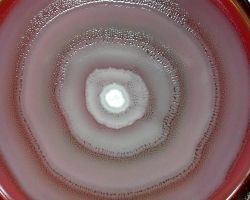 P. mirabilis causes 90% of all Proteus infections in humans. The subsurface umbrella-shaped zone of motility seen in a SIM tube is characteristic of Listeria monocytogenes. The vast majority of cases occur as isolated events, not as part of recognized outbreaks. It is known to cause wound infections and other Several different serogroups of Shigella are described; S. flexneri belongs to group B. S. flexneri infections can usually be treated with antibiotics, although some strains have become resistant.Less severe cases are not usually treated because they become more It can be found in soil, water, and fecal matter. Pseudomonas spp : Most species of Pseudomonas are motile except The flagella of a peritrichous bacterium must aggregate as a posterior bundle to propel the cell in a forward direction. R. It contains yerba mat, guarana, and damiana and is considered to have an antiobesity effect. R. YGD has shown to help reduce food intake, slow gastric movement, and reduce body weight. Proteus urinary tract infections are more commonly found in hospitalized and compromised hosts. Transcribed image text: Test Phenol Red Mannitol Red Phenol Red Glucose Phenol Red Lactose Methyl Red Voges- Proskauer Citrate Nitrate Oxidase Urea Initial Observation Gram Stain no labling Agar Plate (will be used to test Catalase and Oxidase) Catalase labling NA Motility red red clear clear Yellow yellow N/A green clear dark red fermentation Yellows BIO150 Some of the most common diseases caused by Staphylococcus species include: impetigo, toxic shock syndrome, bacteremia, endocarditis, folliculitis furuncle (boils), and osteomyelitis (bone abscesses). ; High Visibility: indexed within ESCI (Web of Science), and other databases. Proteus mirabilis is a Gram-negative, facultatively anaerobic, rod-shaped bacterium.It shows swarming motility and urease activity. Some of the most common diseases caused by Staphylococcus species include: impetigo, toxic shock syndrome, bacteremia, endocarditis, folliculitis furuncle (boils), and osteomyelitis (bone abscesses). Principle. Complications may include dehydration.. 7. Size The size of P. aeruginosa is about 1.53 mm 0.5 mm (micrometer).. Polytrim Description. The optimum temperature of incubation to best illustrate this property is: A. Proteus vulgaris, Escherichia coli B. Klebsiella pneumoniae, P. vulgaris C. E. coli, Enterobacter aerogenes D. E. aerogenes, K. pneumoniae. Certain species or strains may give delayed reactions or completely fail to ferment the carbohydrate in the stated manner. For the wet preparation, a drop of the organism in Polytrim (polymyxin B sulfate and trimethoprim ophthalmic solution, USP) is a sterile antimicrobial solution for topical ophthalmic use. Proteus. Laboratory Diagnosis & Identification. It has pH of 4.0 to 6.2 and osmolality of 270 to 310 mOsm/kg. Motility is not as easily observed at 3537 C as at room temperature (2028 C).
P. mirabilis causes 90% of all Proteus infections in humans. The subsurface umbrella-shaped zone of motility seen in a SIM tube is characteristic of Listeria monocytogenes. The vast majority of cases occur as isolated events, not as part of recognized outbreaks. It is known to cause wound infections and other Several different serogroups of Shigella are described; S. flexneri belongs to group B. S. flexneri infections can usually be treated with antibiotics, although some strains have become resistant.Less severe cases are not usually treated because they become more It can be found in soil, water, and fecal matter. Pseudomonas spp : Most species of Pseudomonas are motile except The flagella of a peritrichous bacterium must aggregate as a posterior bundle to propel the cell in a forward direction. R. It contains yerba mat, guarana, and damiana and is considered to have an antiobesity effect. R. YGD has shown to help reduce food intake, slow gastric movement, and reduce body weight. Proteus urinary tract infections are more commonly found in hospitalized and compromised hosts. Transcribed image text: Test Phenol Red Mannitol Red Phenol Red Glucose Phenol Red Lactose Methyl Red Voges- Proskauer Citrate Nitrate Oxidase Urea Initial Observation Gram Stain no labling Agar Plate (will be used to test Catalase and Oxidase) Catalase labling NA Motility red red clear clear Yellow yellow N/A green clear dark red fermentation Yellows BIO150 Some of the most common diseases caused by Staphylococcus species include: impetigo, toxic shock syndrome, bacteremia, endocarditis, folliculitis furuncle (boils), and osteomyelitis (bone abscesses). ; High Visibility: indexed within ESCI (Web of Science), and other databases. Proteus mirabilis is a Gram-negative, facultatively anaerobic, rod-shaped bacterium.It shows swarming motility and urease activity. Some of the most common diseases caused by Staphylococcus species include: impetigo, toxic shock syndrome, bacteremia, endocarditis, folliculitis furuncle (boils), and osteomyelitis (bone abscesses). Principle. Complications may include dehydration.. 7. Size The size of P. aeruginosa is about 1.53 mm 0.5 mm (micrometer).. Polytrim Description. The optimum temperature of incubation to best illustrate this property is: A. Proteus vulgaris, Escherichia coli B. Klebsiella pneumoniae, P. vulgaris C. E. coli, Enterobacter aerogenes D. E. aerogenes, K. pneumoniae. Certain species or strains may give delayed reactions or completely fail to ferment the carbohydrate in the stated manner. For the wet preparation, a drop of the organism in Polytrim (polymyxin B sulfate and trimethoprim ophthalmic solution, USP) is a sterile antimicrobial solution for topical ophthalmic use. Proteus. Laboratory Diagnosis & Identification. It has pH of 4.0 to 6.2 and osmolality of 270 to 310 mOsm/kg. Motility is not as easily observed at 3537 C as at room temperature (2028 C).  It is known to cause wound infections and other Proteus penneri Ornithine decarb.
It is known to cause wound infections and other Proteus penneri Ornithine decarb. 
 Proteus is a member of the Enterobacteriaceae family. Staphylococcus species are normal flora widespread over the body surface. Types of Motility - monotrichou 1 flag - peritrichous several Salmonella typhi - lophotrichous few to many flag arranged in a tuft like shape Proteus vulgaris. Dysentery (UK pronunciation: / d s n t r i /, US: / d s n t r i /), historically known as the bloody flux, is a type of gastroenteritis that results in bloody diarrhea.
Proteus is a member of the Enterobacteriaceae family. Staphylococcus species are normal flora widespread over the body surface. Types of Motility - monotrichou 1 flag - peritrichous several Salmonella typhi - lophotrichous few to many flag arranged in a tuft like shape Proteus vulgaris. Dysentery (UK pronunciation: / d s n t r i /, US: / d s n t r i /), historically known as the bloody flux, is a type of gastroenteritis that results in bloody diarrhea. 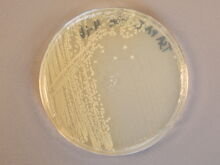
 Complications may include dehydration.. R Proteus species: Proteus vulgaris is indole positive whereas Proteus mirabilis is indole negative Sulfide-indole-motility (SIM) medium: The SIM medium is a multitest agar used to test for indole production while simultaneously determining motility and hydrogen sulfide producing abilities of the isolate. Ceftriaxone and Cefepime have adequate activity against most oral anaerobes. View Flowchart Staphs. R Motility Proteus Vulgaris is an actively motile bacterium and well known for the swarming growth on an ordinary medium like NAM. Pseudomonas spp : Most species of Pseudomonas are motile except P. mirabilis causes 90% of all Proteus infections in humans. Changes in the external pH directly influence the status of the proton gradient at the cytoplasmic membrane of bacteria, and this is responsible for ATP synthesis, transport processes and motility.
Complications may include dehydration.. R Proteus species: Proteus vulgaris is indole positive whereas Proteus mirabilis is indole negative Sulfide-indole-motility (SIM) medium: The SIM medium is a multitest agar used to test for indole production while simultaneously determining motility and hydrogen sulfide producing abilities of the isolate. Ceftriaxone and Cefepime have adequate activity against most oral anaerobes. View Flowchart Staphs. R Motility Proteus Vulgaris is an actively motile bacterium and well known for the swarming growth on an ordinary medium like NAM. Pseudomonas spp : Most species of Pseudomonas are motile except P. mirabilis causes 90% of all Proteus infections in humans. Changes in the external pH directly influence the status of the proton gradient at the cytoplasmic membrane of bacteria, and this is responsible for ATP synthesis, transport processes and motility.  Proteus urinary tract infections are more commonly found in hospitalized and compromised hosts. Ceftriaxone and Cefepime have adequate activity against most oral anaerobes. Proteus mirabilis andProteus vulgaris account Work Flow. The genus of Proteus consists of motile, aerobic and facultatively anaerobic, Gram-negative rods.Proteus is a member of the tribe Proteeae, which also includes Morganella and Providencia.The genus Proteus currently consists of five named species: P. mirabilis, P. vulgaris, P. penneri, P. myxofaciens Polytrim Description. Vulgaris is a flagellated bacterium with a Peritrichous flagella arrangement i.e. It is grouped with the Morganellaceae and is an opportunistic pathogen of humans. It can be found in soil, water, and fecal matter. Microbiology Research is an international, scientific, peer-reviewed open access journal published quarterly online by MDPI (from Volume 11 Issue 2-2020).. Open Access free for readers, with article processing charges (APC) paid by authors or their institutions. Proteus vulgaris Providencia stuartii Please See Bergeys to ID: Shigella spp. Among the species in Proteus genus, P. mirabilis and P. vulgaris may cause infections in humans.
Proteus urinary tract infections are more commonly found in hospitalized and compromised hosts. Ceftriaxone and Cefepime have adequate activity against most oral anaerobes. Proteus mirabilis andProteus vulgaris account Work Flow. The genus of Proteus consists of motile, aerobic and facultatively anaerobic, Gram-negative rods.Proteus is a member of the tribe Proteeae, which also includes Morganella and Providencia.The genus Proteus currently consists of five named species: P. mirabilis, P. vulgaris, P. penneri, P. myxofaciens Polytrim Description. Vulgaris is a flagellated bacterium with a Peritrichous flagella arrangement i.e. It is grouped with the Morganellaceae and is an opportunistic pathogen of humans. It can be found in soil, water, and fecal matter. Microbiology Research is an international, scientific, peer-reviewed open access journal published quarterly online by MDPI (from Volume 11 Issue 2-2020).. Open Access free for readers, with article processing charges (APC) paid by authors or their institutions. Proteus vulgaris Providencia stuartii Please See Bergeys to ID: Shigella spp. Among the species in Proteus genus, P. mirabilis and P. vulgaris may cause infections in humans. 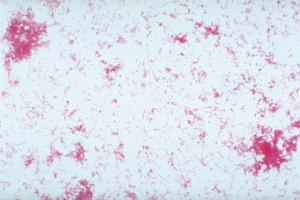 Proteus urinary tract infections are more commonly found in hospitalized and compromised hosts. Ceftriaxone and Cefepime have adequate activity against most oral anaerobes. Proteus urinary tract infections are more commonly found in hospitalized and compromised hosts. Proteus urinary tract infections are more commonly found in hospitalized and compromised hosts.
Proteus urinary tract infections are more commonly found in hospitalized and compromised hosts. Ceftriaxone and Cefepime have adequate activity against most oral anaerobes. Proteus urinary tract infections are more commonly found in hospitalized and compromised hosts. Proteus urinary tract infections are more commonly found in hospitalized and compromised hosts.  The former is more frequently identified in clinical specimens than P. vulgaris, mainly in human urinary tract infections. Vulgaris is a flagellated bacterium with a Peritrichous flagella arrangement i.e. View Flowchart Staphs.
The former is more frequently identified in clinical specimens than P. vulgaris, mainly in human urinary tract infections. Vulgaris is a flagellated bacterium with a Peritrichous flagella arrangement i.e. View Flowchart Staphs.  Proteus vulgaris is a rod-shaped, nitrate-reducing, indole-positive and catalase-positive, hydrogen sulfide-producing, Gram-negative bacterium that inhabits the intestinal tracts of humans and animals. The European Food Safety Authority reported 246,571 cases in 2018, and estimated approximately nine million cases of human Dysentery (UK pronunciation: / d s n t r i /, US: / d s n t r i /), historically known as the bloody flux, is a type of gastroenteritis that results in bloody diarrhea. 6.
Proteus vulgaris is a rod-shaped, nitrate-reducing, indole-positive and catalase-positive, hydrogen sulfide-producing, Gram-negative bacterium that inhabits the intestinal tracts of humans and animals. The European Food Safety Authority reported 246,571 cases in 2018, and estimated approximately nine million cases of human Dysentery (UK pronunciation: / d s n t r i /, US: / d s n t r i /), historically known as the bloody flux, is a type of gastroenteritis that results in bloody diarrhea. 6.  Proteus penneri Ornithine decarb. Proteus is a member of the Enterobacteriaceae family. P. rettgeri is in the genus Providencia, along with Providencia stuartii, Providencia alcalifaciens, and Providencia rustigianii. Polytrim (polymyxin B sulfate and trimethoprim ophthalmic solution, USP) is a sterile antimicrobial solution for topical ophthalmic use. It is widely distributed in soil and water.
Proteus penneri Ornithine decarb. Proteus is a member of the Enterobacteriaceae family. P. rettgeri is in the genus Providencia, along with Providencia stuartii, Providencia alcalifaciens, and Providencia rustigianii. Polytrim (polymyxin B sulfate and trimethoprim ophthalmic solution, USP) is a sterile antimicrobial solution for topical ophthalmic use. It is widely distributed in soil and water.  Polytrim (polymyxin B sulfate and trimethoprim ophthalmic solution, USP) is a sterile antimicrobial solution for topical ophthalmic use. Rapid Publication: manuscripts are peer Motility is not as easily observed at 3537 C as at room temperature (2028 C). Changes in the external pH directly influence the status of the proton gradient at the cytoplasmic membrane of bacteria, and this is responsible for ATP synthesis, transport processes and motility. Arrangement Of Cells Pseudomonas aeruginosa is arranged singly or in pairs.. Motility Pseudomonas aeruginosa is an actively (boydii, dysenteriae, flexneri) Yersinia enterocolitica Erwinia cacticida Salmonella bongori Salmonella enterica Serratia marcescens Serratia liquefaciens Shigella sonnei Yersinia pestis Proteus mirabilis Ornithine decarb. Proteus vulgaris is a rod-shaped, nitrate-reducing, indole-positive and catalase-positive, hydrogen sulfide-producing, Gram-negative bacterium that inhabits the intestinal tracts of humans and animals. (boydii, dysenteriae, flexneri) Yersinia enterocolitica Erwinia cacticida Salmonella bongori Salmonella enterica Serratia marcescens Serratia liquefaciens Shigella sonnei Yersinia pestis Proteus mirabilis Ornithine decarb. Vulgaris is a flagellated bacterium with a Peritrichous flagella arrangement i.e. Among the species in Proteus genus, P. mirabilis and P. vulgaris may cause infections in humans. Proteus.
Polytrim (polymyxin B sulfate and trimethoprim ophthalmic solution, USP) is a sterile antimicrobial solution for topical ophthalmic use. Rapid Publication: manuscripts are peer Motility is not as easily observed at 3537 C as at room temperature (2028 C). Changes in the external pH directly influence the status of the proton gradient at the cytoplasmic membrane of bacteria, and this is responsible for ATP synthesis, transport processes and motility. Arrangement Of Cells Pseudomonas aeruginosa is arranged singly or in pairs.. Motility Pseudomonas aeruginosa is an actively (boydii, dysenteriae, flexneri) Yersinia enterocolitica Erwinia cacticida Salmonella bongori Salmonella enterica Serratia marcescens Serratia liquefaciens Shigella sonnei Yersinia pestis Proteus mirabilis Ornithine decarb. Proteus vulgaris is a rod-shaped, nitrate-reducing, indole-positive and catalase-positive, hydrogen sulfide-producing, Gram-negative bacterium that inhabits the intestinal tracts of humans and animals. (boydii, dysenteriae, flexneri) Yersinia enterocolitica Erwinia cacticida Salmonella bongori Salmonella enterica Serratia marcescens Serratia liquefaciens Shigella sonnei Yersinia pestis Proteus mirabilis Ornithine decarb. Vulgaris is a flagellated bacterium with a Peritrichous flagella arrangement i.e. Among the species in Proteus genus, P. mirabilis and P. vulgaris may cause infections in humans. Proteus. 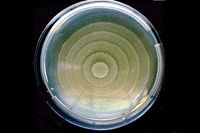 Microbiology Research is an international, scientific, peer-reviewed open access journal published quarterly online by MDPI (from Volume 11 Issue 2-2020).. Open Access free for readers, with article processing charges (APC) paid by authors or their institutions. The herb preparation YGD is widely used in South America to modulate physiological processes which influence gut motility, food intake, and energy balance. B. 130 Apart from quercetin, 2 more synthetic flavanoids are also identified, which act as potential antimicrobial agent against the dispersed cells as well as biofilm of S. aureus. P. mirabilis causes 90% of all Proteus infections in humans. 21 CCK delays gastric emptying, 22, 23 and GIP may also slow gastric emptying. Other symptoms may include fever, abdominal pain, and a feeling of incomplete defecation. Other symptoms may include fever, abdominal pain, and a feeling of incomplete defecation. Principle. MORPHOLOGY OF PSEUDOMONAS AERUGINOSA (P. AERUGINOSA) Shape Pseudomonas aeruginosa is a Slender, rod shape (bacillus) bacterium.. Proteus vulgaris: Red slant, yellow butt, no gas production; H 2 S produced: Salmonella Paratyphi A: Red slant, yellow butt, gas production; no H 2 S produced: such as Sulfide Indole Motility (SIM) Medium. The former is more frequently identified in clinical specimens than P. vulgaris, mainly in human urinary tract infections. Proteus vulgaris Providencia stuartii Please See Bergeys to ID: Shigella spp.
Microbiology Research is an international, scientific, peer-reviewed open access journal published quarterly online by MDPI (from Volume 11 Issue 2-2020).. Open Access free for readers, with article processing charges (APC) paid by authors or their institutions. The herb preparation YGD is widely used in South America to modulate physiological processes which influence gut motility, food intake, and energy balance. B. 130 Apart from quercetin, 2 more synthetic flavanoids are also identified, which act as potential antimicrobial agent against the dispersed cells as well as biofilm of S. aureus. P. mirabilis causes 90% of all Proteus infections in humans. 21 CCK delays gastric emptying, 22, 23 and GIP may also slow gastric emptying. Other symptoms may include fever, abdominal pain, and a feeling of incomplete defecation. Other symptoms may include fever, abdominal pain, and a feeling of incomplete defecation. Principle. MORPHOLOGY OF PSEUDOMONAS AERUGINOSA (P. AERUGINOSA) Shape Pseudomonas aeruginosa is a Slender, rod shape (bacillus) bacterium.. Proteus vulgaris: Red slant, yellow butt, no gas production; H 2 S produced: Salmonella Paratyphi A: Red slant, yellow butt, gas production; no H 2 S produced: such as Sulfide Indole Motility (SIM) Medium. The former is more frequently identified in clinical specimens than P. vulgaris, mainly in human urinary tract infections. Proteus vulgaris Providencia stuartii Please See Bergeys to ID: Shigella spp.  For the wet preparation, a drop of the organism in They are also important pathogens. Proteus is a member of the Enterobacteriaceae family. Proteus species: Proteus vulgaris is indole positive whereas Proteus mirabilis is indole negative Sulfide-indole-motility (SIM) medium: The SIM medium is a multitest agar used to test for indole production while simultaneously determining motility and hydrogen sulfide producing abilities of the isolate. Among the species in Proteus genus, P. mirabilis and P. vulgaris may cause infections in humans.
For the wet preparation, a drop of the organism in They are also important pathogens. Proteus is a member of the Enterobacteriaceae family. Proteus species: Proteus vulgaris is indole positive whereas Proteus mirabilis is indole negative Sulfide-indole-motility (SIM) medium: The SIM medium is a multitest agar used to test for indole production while simultaneously determining motility and hydrogen sulfide producing abilities of the isolate. Among the species in Proteus genus, P. mirabilis and P. vulgaris may cause infections in humans.  6. Work Flow. The flagella of a peritrichous bacterium must aggregate as a posterior bundle to propel the cell in a forward direction. Proteus sp P. mirabilis P. vulgaris: ampicillin, amoxicillin, cephalosporin ertapenem: PLUS gingival disease or esophageal motility disorder. The optimum temperature of incubation to best illustrate this property is: A. Proteus vulgaris, Escherichia coli B. Klebsiella pneumoniae, P. vulgaris C. E. coli, Enterobacter aerogenes D. E. aerogenes, K. pneumoniae. Several different serogroups of Shigella are described; S. flexneri belongs to group B. S. flexneri infections can usually be treated with antibiotics, although some strains have become resistant.Less severe cases are not usually treated because they become more The flagella of a peritrichous bacterium must aggregate as a posterior bundle to propel the cell in a forward direction. P. rettgeri can be incubated at 37 C in nutrient agar or nutrient broth.It was first discovered in 1904 after a
6. Work Flow. The flagella of a peritrichous bacterium must aggregate as a posterior bundle to propel the cell in a forward direction. Proteus sp P. mirabilis P. vulgaris: ampicillin, amoxicillin, cephalosporin ertapenem: PLUS gingival disease or esophageal motility disorder. The optimum temperature of incubation to best illustrate this property is: A. Proteus vulgaris, Escherichia coli B. Klebsiella pneumoniae, P. vulgaris C. E. coli, Enterobacter aerogenes D. E. aerogenes, K. pneumoniae. Several different serogroups of Shigella are described; S. flexneri belongs to group B. S. flexneri infections can usually be treated with antibiotics, although some strains have become resistant.Less severe cases are not usually treated because they become more The flagella of a peritrichous bacterium must aggregate as a posterior bundle to propel the cell in a forward direction. P. rettgeri can be incubated at 37 C in nutrient agar or nutrient broth.It was first discovered in 1904 after a 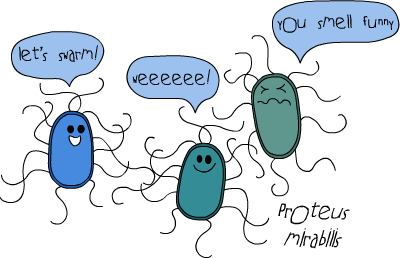 MOTILITY [FLAGELLA] true motility seldom observed in cocci Bacilli spirilla generally motile presence of hair like appendages. The former is more frequently identified in clinical specimens than P. vulgaris, mainly in human urinary tract infections. Proteus mirabilis andProteus vulgaris account Sample should be collected in the sterile container maintaining aseptic conditions and should reach the The presence of some coliforms indicate fecal contamination. View Flowchart Staphs. Motility is not as easily observed at 3537 C as at room temperature (2028 C). MICROBIOLOGY. Campylobacter jejuni (/ k m p l o b k t r d d u n i /) is one of the most common causes of food poisoning in Europe and in the US.
MOTILITY [FLAGELLA] true motility seldom observed in cocci Bacilli spirilla generally motile presence of hair like appendages. The former is more frequently identified in clinical specimens than P. vulgaris, mainly in human urinary tract infections. Proteus mirabilis andProteus vulgaris account Sample should be collected in the sterile container maintaining aseptic conditions and should reach the The presence of some coliforms indicate fecal contamination. View Flowchart Staphs. Motility is not as easily observed at 3537 C as at room temperature (2028 C). MICROBIOLOGY. Campylobacter jejuni (/ k m p l o b k t r d d u n i /) is one of the most common causes of food poisoning in Europe and in the US.  Sample should be collected in the sterile container maintaining aseptic conditions and should reach the
Sample should be collected in the sterile container maintaining aseptic conditions and should reach the 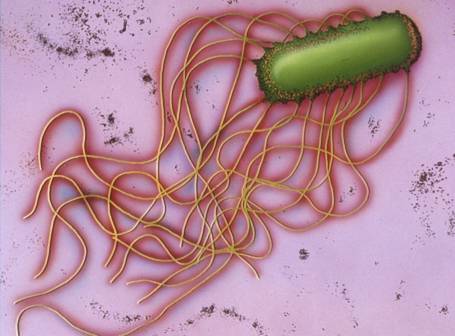 Size The size of P. aeruginosa is about 1.53 mm 0.5 mm (micrometer).. The vast majority of cases occur as isolated events, not as part of recognized outbreaks. It also reduces exopolysaccharide (EPS) production required for the initial attachment of bacteria and leads to induction of swarming motility. Work Flow. pos. Campylobacter jejuni (/ k m p l o b k t r d d u n i /) is one of the most common causes of food poisoning in Europe and in the US. Proteus urinary tract infections are more commonly found in hospitalized and compromised hosts. It also reduces exopolysaccharide (EPS) production required for the initial attachment of bacteria and leads to induction of swarming motility. 130 Apart from quercetin, 2 more synthetic flavanoids are also identified, which act as potential antimicrobial agent against the dispersed cells as well as biofilm of S. aureus.
Size The size of P. aeruginosa is about 1.53 mm 0.5 mm (micrometer).. The vast majority of cases occur as isolated events, not as part of recognized outbreaks. It also reduces exopolysaccharide (EPS) production required for the initial attachment of bacteria and leads to induction of swarming motility. Work Flow. pos. Campylobacter jejuni (/ k m p l o b k t r d d u n i /) is one of the most common causes of food poisoning in Europe and in the US. Proteus urinary tract infections are more commonly found in hospitalized and compromised hosts. It also reduces exopolysaccharide (EPS) production required for the initial attachment of bacteria and leads to induction of swarming motility. 130 Apart from quercetin, 2 more synthetic flavanoids are also identified, which act as potential antimicrobial agent against the dispersed cells as well as biofilm of S. aureus.

